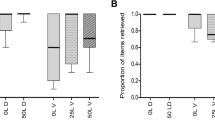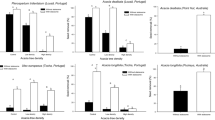Abstract
Seed dispersal by ants (myrmecochory) is mediated by the presence of a lipid-rich appendage (elaiosome) on the seed that induces a variety of ants to collect the diaspores. When seeds mature or fall onto the ground, these ant species transport them to their nest. After eating the elaiosome, the seed is discarded in nest galleries or outside, in the midden or farther away, where seeds can potentially germinate. The final location of seeds with their elaiosomes removed was evaluated to assess the importance of possible handles (structures that ants can grasp to carry) in transporting ants during re-dispersal experiments of seeds from nests of six species of ants. The results indicate that seeds remained within the nest because the ants were not able to transport them out of the nest. As a consequence of the elaiosome being removed, small ant species could not take Euphorbia characias seeds out of their nests. Only large ant species could remove E. characias seeds from their nests. Attaching an artificial handle to E. characias seeds allowed small ant species to redistribute the seeds from their nests. On the other hand, Rhamnus alaternus seeds that have a natural handle after the elaiosome removal were removed from the nests by both groups of ant species. If a seed has an element that acts as a handle, it will eventually get taken out of the nest. The ants’ size and their mandible gap can determine the outcome of the interaction (i.e. the pattern of the final seed shadow) and as a consequence, could influence the events that take place after the dispersal process.
Similar content being viewed by others
References
Byrne MM, Levey DJ (1993) Removal of seeds from frugivore defecations by ants in a Costa Rican rain forest. Vegetatio 107/108:363–374
Christian CE, Stanton ML (2004) Cryptic consequences of a dispersal mutualism: seed burial, elaiosome removal, and seed-bank dynamics. Ecology 85:1101–1110
Gómez C, Espadaler X (1998) Aphaenogaster senilis Mayr (Hymenoptera, Formicidae): a possible parasite in the myrmecochory of Euphorbia characias. Sociobiology 32:441–450
Gorb EV, Gorb SN (2003) Seed dispersal by ants in a deciduous forest ecosystem: mechanisms, strategies, adaptations. Kluwer, Dordrecht
Horvitz CC, LeCorff J (1993) Spatial scale and dispersion pattern of ant- and bird-dispersed herbs in two tropicals lowland rain forests. Vegetatio 107/108:351–362
Howe HF (1989) Scatter- and clump-dispersal and seedling demography: hypothesis and implications. Oecologia 79:417–426
Hughes L, Westoby M (1992) Fate of seeds adapted for dispersal by ants in Australia sclerophyll vegetation. Ecology 73:1285–1299
Acknowledgements
We would like to thank Josep Morera and the Sangrà family for allowing us to work on their properties. We also thank David Casellas and Gemma Vila for field and laboratory assistance. E. Garcia-Berthou and two anonymous reviewers revised a previous draft of the manuscript. This study was funded by the Ministry of Education and Science of the Spanish Government (CGL2004-05240/BOS). The experiments comply with the current Spanish laws.
Author information
Authors and Affiliations
Corresponding author
Additional information
Communicated by Christian Koerner
Rights and permissions
About this article
Cite this article
Gómez, C., Espadaler, X. & Bas, J.M. Ant behaviour and seed morphology: a missing link of myrmecochory. Oecologia 146, 244–246 (2005). https://doi.org/10.1007/s00442-005-0200-7
Received:
Accepted:
Published:
Issue Date:
DOI: https://doi.org/10.1007/s00442-005-0200-7




